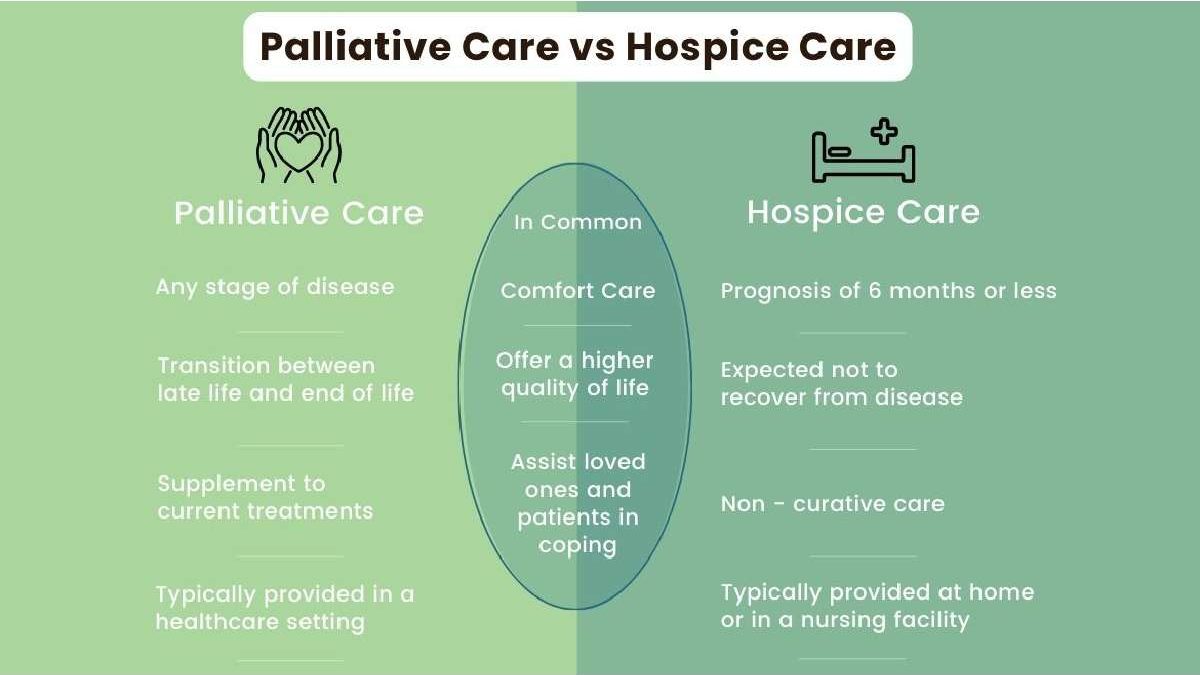Understanding Palliative vs. Hospice Care – When it comes to caring for someone with a serious illness, understanding the available care options is crucial. Two common types of care that are often confused are palliative care and hospice care. While both are designed to improve the quality of life for patients facing life-threatening conditions, they have distinct differences in terms of goals, eligibility, and timing. Knowing these differences can help families make informed decisions about the best care for their loved ones.
Table of Contents
Understanding Palliative vs. Hospice Care – What Is Palliative Care?
Palliative care is a specialized form of medical care for individuals living with serious illnesses. The primary focus of palliative care is to provide relief from the symptoms and stress associated with the illness, regardless of the diagnosis. This type of care can be provided alongside curative treatments and is available to patients at any stage of their illness.
Key Features of Palliative Care
Symptom Management: Palliative care professionals focus on alleviating physical discomfort, such as pain, nausea, and shortness of breath, as well as addressing emotional and psychological concerns.
Quality of Life: The goal is to enhance the patient’s quality of life by ensuring that their needs—physical, emotional, and spiritual—are addressed.
Patient and Family Support: Palliative care teams provide guidance and support to both the patient and their families, helping them navigate the complexities of their medical condition.
Flexible Timeline: Unlike hospice care, palliative care can begin at any point in a serious illness and does not require patients to forego curative treatment.
Palliative care is usually offered in hospitals, outpatient clinics, and at home. It is an option for people of all ages dealing with chronic illnesses such as cancer, heart disease, and dementia.
Understanding Palliative vs. Hospice Care – What Is Hospice Care?
Hospice care is a type of care focused on providing comfort rather than curing the disease. It is typically recommended for individuals who have been diagnosed with a terminal illness and are expected to live for six months or less. The goal of hospice is to support the patient and their family through the final stages of life by providing compassionate, holistic care.
Key Features of Hospice Care
Comfort over Cure: Hospice care is not about curing the illness but rather about ensuring the patient’s comfort during their final months.
Eligibility Requirements: Hospice care is available to patients with a life expectancy of six months or less, who are no longer seeking curative treatment.
Comprehensive Care Team: The hospice care team includes doctors, nurses, social workers, spiritual counselors, and volunteers who collaborate to meet the physical, emotional, and spiritual needs of the patient and their family.
Home-Based Care: While hospice care can be provided in hospitals and dedicated facilities, it is often delivered in the patient’s home to provide a familiar and comforting environment during their last days.
A major difference between hospice and palliative care is the focus on the patient’s comfort over treatment. Hospice care ensures that patients experience peace, dignity, and as little suffering as possible during their remaining time.
Differences Between Palliative and Hospice Care
Although palliative and hospice care share some common goals, they differ in several key areas:
-
Timing of Care
Palliative Care: Can begin at any time during the course of an illness, even when curative treatments are being pursued.
Hospice Care: Begins when the patient has a terminal diagnosis and curative treatments are no longer an option.
-
Goals of Care
Palliative Care: Aims to improve quality of life by managing symptoms and supporting patients and families, while still allowing for curative treatments.
Hospice Care: Focuses on comfort and symptom management for patients in the final stages of life, without curative treatment.
-
Eligibility
Palliative Care: Available to anyone with a serious illness, regardless of the stage or prognosis.
Hospice Care: Limited to individuals with a terminal diagnosis and a life expectancy of six months or less.
-
Location of Care
Palliative Care: Can be provided in various settings, including hospitals, outpatient clinics, and at home.
Hospice Care: Often takes place in the patient’s home, though it can also be delivered in hospice centers and hospitals.
When Should You Consider Palliative or Hospice Care?
Choosing between palliative and hospice care depends on several factors, including the stage of the illness, the patient’s goals, and the available treatment options. Palliative care is a good choice for patients who are still receiving treatment for their illness but need help managing symptoms. On the other hand, hospice care is appropriate for those who are nearing the end of life and want to focus on comfort rather than aggressive treatments.
It’s important to have open conversations with healthcare providers to determine the best care option for your loved one. Asking about the goals of care, available treatments, and the patient’s wishes will guide the decision-making process.
How to Access Care
Access to palliative and hospice care often depends on the healthcare provider, location, and insurance coverage. In most cases, palliative care can be arranged through a hospital or specialist. Hospice care, however, may require a referral from a doctor confirming the patient’s terminal diagnosis.
In Virginia hospice services are available to provide compassionate care for those nearing the end of life. You can learn more about the services and how to access them through Virginia hospice.
Conclusion
Understanding Palliative vs. Hospice Care – Understanding the key differences between palliative care and hospice care can help families make the best decisions for their loved ones. While both types of care aim to improve the quality of life, the right choice depends on the patient’s condition, treatment goals, and stage of illness. By exploring the options early and engaging in open dialogue with healthcare providers, families can ensure that their loved ones receive the care they need to live comfortably and with dignity.

